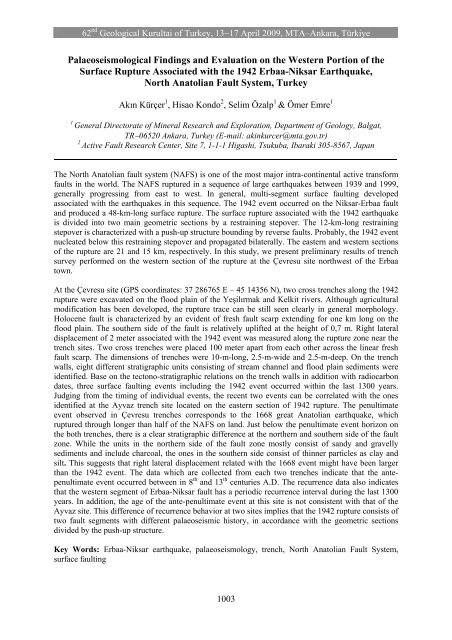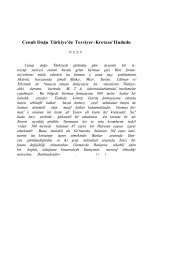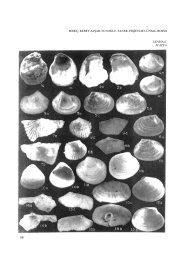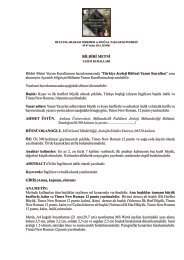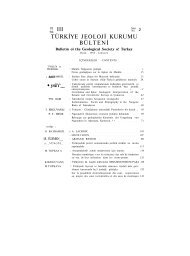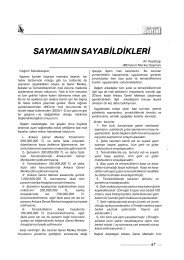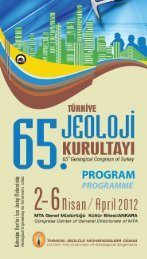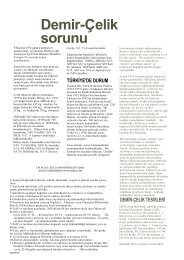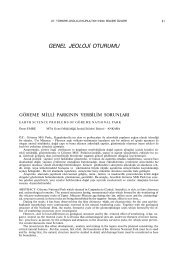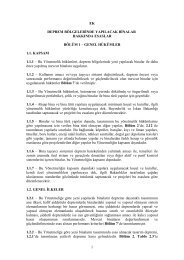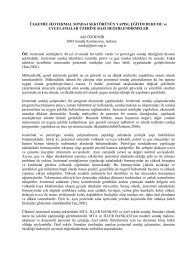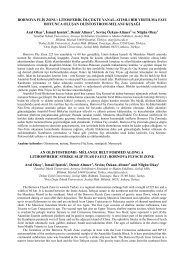Paleosismoloji ve Arkeosismoloji Palaeoseismology and ...
Paleosismoloji ve Arkeosismoloji Palaeoseismology and ...
Paleosismoloji ve Arkeosismoloji Palaeoseismology and ...
Create successful ePaper yourself
Turn your PDF publications into a flip-book with our unique Google optimized e-Paper software.
62 nd Geological Kurultai of Turkey, 13−17 April 2009, MTA–Ankara, Türkiye<br />
Palaeoseismological Findings <strong>and</strong> Evaluation on the Western Portion of the<br />
Surface Rupture Associated with the 1942 Erbaa-Niksar Earthquake,<br />
North Anatolian Fault System, Turkey<br />
Akın Kürçer 1 , Hisao Kondo 2 , Selim Özalp 1 & Ömer Emre 1<br />
1<br />
General Directorate of Mineral Research <strong>and</strong> Exploration, Department of Geology, Balgat,<br />
TR−06520 Ankara, Turkey (E-mail: akinkurcer@mta.gov.tr)<br />
2<br />
Acti<strong>ve</strong> Fault Research Center, Site 7, 1-1-1 Higashi, Tsukuba, Ibaraki 305-8567, Japan<br />
The North Anatolian fault system (NAFS) is one of the most major intra-continental acti<strong>ve</strong> transform<br />
faults in the world. The NAFS ruptured in a sequence of large earthquakes between 1939 <strong>and</strong> 1999,<br />
generally progressing from east to west. In general, multi-segment surface faulting de<strong>ve</strong>loped<br />
associated with the earthquakes in this sequence. The 1942 e<strong>ve</strong>nt occurred on the Niksar-Erbaa fault<br />
<strong>and</strong> produced a 48-km-long surface rupture. The surface rupture associated with the 1942 earthquake<br />
is divided into two main geometric sections by a restraining stepo<strong>ve</strong>r. The 12-km-long restraining<br />
stepo<strong>ve</strong>r is characterized with a push-up structure bounding by re<strong>ve</strong>rse faults. Probably, the 1942 e<strong>ve</strong>nt<br />
nucleated below this restraining stepo<strong>ve</strong>r <strong>and</strong> propagated bilaterally. The eastern <strong>and</strong> western sections<br />
of the rupture are 21 <strong>and</strong> 15 km, respecti<strong>ve</strong>ly. In this study, we present preliminary results of trench<br />
sur<strong>ve</strong>y performed on the western section of the rupture at the Çevresu site northwest of the Erbaa<br />
town.<br />
At the Çevresu site (GPS coordinates: 37 286765 E – 45 14356 N), two cross trenches along the 1942<br />
rupture were excavated on the flood plain of the Yeşilırmak <strong>and</strong> Kelkit ri<strong>ve</strong>rs. Although agricultural<br />
modification has been de<strong>ve</strong>loped, the rupture trace can be still seen clearly in general morphology.<br />
Holocene fault is characterized by an evident of fresh fault scarp extending for one km long on the<br />
flood plain. The southern side of the fault is relati<strong>ve</strong>ly uplifted at the height of 0,7 m. Right lateral<br />
displacement of 2 meter associated with the 1942 e<strong>ve</strong>nt was measured along the rupture zone near the<br />
trench sites. Two cross trenches were placed 100 meter apart from each other across the linear fresh<br />
fault scarp. The dimensions of trenches were 10-m-long, 2.5-m-wide <strong>and</strong> 2.5-m-deep. On the trench<br />
walls, eight different stratigraphic units consisting of stream channel <strong>and</strong> flood plain sediments were<br />
identified. Base on the tectono-stratigraphic relations on the trench walls in addition with radiocarbon<br />
dates, three surface faulting e<strong>ve</strong>nts including the 1942 e<strong>ve</strong>nt occurred within the last 1300 years.<br />
Judging from the timing of individual e<strong>ve</strong>nts, the recent two e<strong>ve</strong>nts can be correlated with the ones<br />
identified at the Ayvaz trench site located on the eastern section of 1942 rupture. The penultimate<br />
e<strong>ve</strong>nt obser<strong>ve</strong>d in Çevresu trenches corresponds to the 1668 great Anatolian earthquake, which<br />
ruptured through longer than half of the NAFS on l<strong>and</strong>. Just below the penultimate e<strong>ve</strong>nt horizon on<br />
the both trenches, there is a clear stratigraphic difference at the northern <strong>and</strong> southern side of the fault<br />
zone. While the units in the northern side of the fault zone mostly consist of s<strong>and</strong>y <strong>and</strong> gra<strong>ve</strong>lly<br />
sediments <strong>and</strong> include charcoal, the ones in the southern side consist of thinner particles as clay <strong>and</strong><br />
silt. This suggests that right lateral displacement related with the 1668 e<strong>ve</strong>nt might ha<strong>ve</strong> been larger<br />
than the 1942 e<strong>ve</strong>nt. The data which are collected from each two trenches indicate that the antepenultimate<br />
e<strong>ve</strong>nt occurred between in 8 th <strong>and</strong> 13 th centuries A.D. The recurrence data also indicates<br />
that the western segment of Erbaa-Niksar fault has a periodic recurrence interval during the last 1300<br />
years. In addition, the age of the ante-penultimate e<strong>ve</strong>nt at this site is not consistent with that of the<br />
Ayvaz site. This difference of recurrence behavior at two sites implies that the 1942 rupture consists of<br />
two fault segments with different palaeoseismic history, in accordance with the geometric sections<br />
divided by the push-up structure.<br />
Key Words: Erbaa-Niksar earthquake, palaeoseismology, trench, North Anatolian Fault System,<br />
surface faulting<br />
1003


